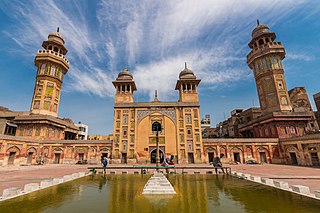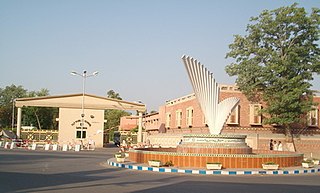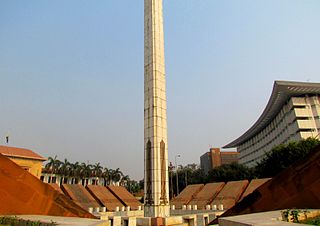
Charing Cross, officially known as Faisal Chowk, is a major road intersection in Lahore, Punjab, Pakistan. Located on Shahrah-e-Quaid-e-Azam, it is a popular site for protests within Lahore. [1]

Charing Cross, officially known as Faisal Chowk, is a major road intersection in Lahore, Punjab, Pakistan. Located on Shahrah-e-Quaid-e-Azam, it is a popular site for protests within Lahore. [1]
The area was part of Donald Town, a neighborhood named after Sir Donald McLeod, who served as Lieutenant-Governor of Punjab between 1865 and 1870. [2] The planned intersection was developed at a juncture between Queens', Montgomery and Mall roads. It came to be known as Charing Cross, which historians believe is after Charing Cross in London. [3] [4] The name is recorded in a 1908 publication by G.R. Elmslie titled “Thirty Five Years in the Punjab” (1908, Edinburgh). A 1918-19 ‘B&R Report’ refers to it as the ‘Charing Cross Scheme’.
A white marble pavilion, designed by Bhai Ram Singh, was constructed at Charing Cross in 1901 to mark Queen Victoria's jubilee as the first Empress of India. A bronze statue of Victoria, cast in London in 1900, stood at the site in the pavilion from 1904 until 1951, when it was replaced by a model of the Quran. [1] The statue now stands at Lahore Museum. [5]
To commemorate the 2nd Islamic Summit Conference held at Lahore in 1974, the Islamic Summit Minar was constructed at the site. [1] In 1981 Charing Cross was officially renamed Faisal Chowk to honour King Faisal of Saudi Arabia. [6] In February 2013 a suicide bomber murdered at least 14 people at a protest in the area. [1]

Lahore is the second most populous city in Pakistan after Karachi and 26th most populous city in the world, with a population of over 13 million. It is the capital of the province of Punjab where it is the largest city. Lahore is one of Pakistan's major industrial and economic hubs, with an estimated GDP (PPP) of $84 billion as of 2019. It is the largest city as well as the historic capital and cultural centre of the wider Punjab region, and is one of Pakistan's most socially liberal, progressive, and cosmopolitan cities. It is situated in the north-east of the country, close to the International border with India.

The Lahore Fort is a citadel in the city of Lahore, Pakistan. The fortress is located at the northern end of walled city Lahore, and spreads over an area greater than 20 hectares. It contains 21 notable monuments, some of which date to the era of Emperor Akbar. The Lahore Fort is notable for having been almost entirely rebuilt in the 17th century, when the Mughal Empire was at the height of its splendour and opulence.

The Wazir Khan Mosque is a 17th-century mosque located in the city of Lahore, capital of the Pakistani province of Punjab. The mosque was commissioned during the reign of the Mughal Emperor Shah Jahan as a part of an ensemble of buildings that also included the nearby Shahi Hammam baths. Construction of Wazir Khan Mosque began in 1634 C.E., and was completed in 1641. It is on the UNESCO World Heritage Tentative List.

Sargodha is a city and capital of Sargodha Division, located in Punjab province, Pakistan. It is Pakistan's 12th largest city by population and one of the fastest-growing cities of the country. Sargodha is also known as the City of Eagles.
Shahrah-e-Quaid-e-Azam, formerly known as The Mall or Mall Road, is a major road in Lahore, Pakistan.

Chauburji is a Mughal era monument in the city of Lahore, capital of the Pakistani province of Punjab. The monument was built in 1646 C.E. during the reign of the emperor Shah Jahan. It previously acted as a gateway to a large garden.

Government Dyal Singh Graduate College, Lahore is a college for graduate and post-graduate students affiliated to Board of Intermediate and Secondary Education, Lahore and University of the Punjab, Lahore, Pakistan.
Pakistani architecture is intertwined with the architecture of the broader Indian subcontinent. With the beginning of the Indus civilization around the middle of the 3rd millennium BC, for the first time in the area which encompasses today's Pakistan an advanced urban culture developed with large structural facilities, some of which survive to this day. This was followed by the Gandhara style of Buddhist architecture that borrowed elements from Ancient Greece. These remnants are visible in the Gandhara capital of Taxila.

Lahore Masonic Temple in the Charing Cross neighbourhood of Lahore, Pakistan, is the former home of Prince Albert Victor Lodge 2370ec, and Hope and Perseverance Lodge No. 782, two Masonic lodges warranted by the United Grand Lodge of England.

The July 2010 Lahore bombings occurred on 1 July 2010 in Lahore, Punjab, Pakistan. Two suicide bombers blew themselves up at the Sufi shrine, Data Darbar Complex. At least 50 people were killed and 200 others were hurt in the blasts. It was the biggest attack on a Sufi shrine in Pakistan since 2001.

The Summit Minar is an obelisk-shaped structure built in the centre of Charing Cross, Mall Road in the city of Lahore, Punjab the province of Pakistan. It was built to commemorate the second Islamic Summit Conference held in Lahore from 22 to 24 February 1974. It is located in front of WAPDA House and the Punjab Assembly Building.

The WAPDA House is a nine-story office building located in Lahore, Pakistan, that serves as the headquarters of the Water and Power Development Authority (WAPDA). It is one of several prominent government buildings located at Charing Cross on Lahore's Mall Road. The building shares views of the Punjab Provincial Assembly, Islamic Summit Minar, Masonic Lodge, and other key landmarks.

The Naulakha Pavilion is a white marble personal chamber with a curvilinear roof, located beside the Sheesh Mahal courtyard, in the northern section of the Lahore Fort in Lahore, Pakistan. The monument is one of the 21 monuments situated within the Lahore Fort, with its western façade providing a panoramic view of the ancient city of Lahore.

The Badshahi Mosque is a Mughal-era congregational mosque in Lahore, capital of the Pakistani province of Punjab. The mosque is located west of Lahore Fort along the outskirts of the Walled City of Lahore, and is widely considered to be one of Lahore's most iconic landmarks.
Garhi Shahu is a union council and historic neighbourhood in Gulberg Tehsil of Lahore, Punjab, Pakistan. Garhi Shahu is one of Lahore's oldest residential neighbourhoods outside the Old City and is located near Lahore Junction railway station. Garhi Shahu is home to imposing government buildings like the huge Governor’s House, with colonial-era Indo-Gothic arches and Palladian colonnades, and the 1938 Punjab Assembly. In a modern building, the Alhamra Art Center stages drama and art exhibitions, while Al-Falah Theatre shows popular plays and comedy well known talented Hip-Hop Artist Mr Dawar also belongs from Garhi Shahu. The area is named after notorious 19th-century gang leader and robber baron Shahu.
The following is a timeline of the history of the city of Lahore, Pakistan.

The 2014 Azadi movement, or 2014 Freedom movement also known as the Tsunami March, was a protest march in Pakistan from 14 August to 17 December 2014. The march was organised by the Pakistan Tehreek-e-Insaf (PTI) party, opposing Prime Minister Mian Nawaz Sharif over claims of systematic election-rigging by the Pakistan Muslim League (N) (PML-N) in the 2013 general election that was later order for reelection and PTI won one out of three seats from the four claimed seats. Party leader Imran Khan had announced plans for an August march from Lahore to Islamabad with a group of protesters in a PTI jalsa (demonstration) in Bahawalpur on 27 June 2014. On 17 December, a day after the 2014 Peshawar school massacre, Khan called off the protest.
On 13 February 2017, a suicide bombing took place on the Mall Road in Lahore, Pakistan, where a group of chemists and pharmacists were holding a protest at Charing Cross in front of the Punjab provincial assembly. According to Punjab Police sources, 18 people were killed, including several police officials, and at least 87 were injured.